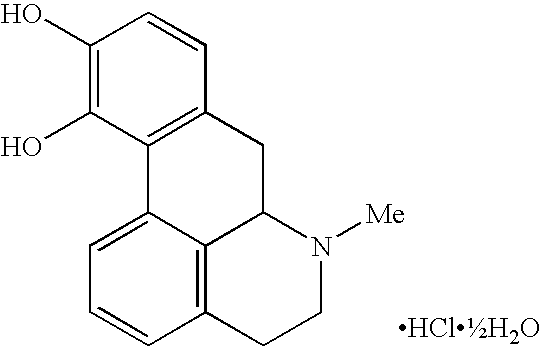Intranasal compositions
a composition and intranasal technology, applied in the field of liquid pharmaceutical compositions, can solve the problems of drug precipitation out of solution, unsuitable preparation of drug formulations, unreliable and/or variable amount of drug being administered,
- Summary
- Abstract
- Description
- Claims
- Application Information
AI Technical Summary
Benefits of technology
Problems solved by technology
Method used
Image
Examples
example 1
Preparation of Water for Making Intranasal Formulations
[0087]500 ml of water was dispensed into a 1 litre beaker. The water was heated to boiling point and boiled for 5 minutes. The beaker was then covered and the contents left to cool. Using 1 M hydrochloric acid solution, the pH of the water was adjusted into the range of from 3.5 to 4.0. The water was transferred to a bottle and the bottle tightly sealed with a lid. Just prior to be used for formulation preparation the water was purged with nitrogen for two minutes.
[0088]This water was used in Examples 2 to 5.
example 2
Solution Containing 35 mg / ml Apomorphine Hydrochloride, 200 mg / ml Poloxamer 188, 1 mg / ml Sodium Metabisulfite and 0.15 mg / ml Benzalkonium Chloride (Unbuffered)
[0089]10 g of poloxamer 188 (Lutrol™ F68, BASF, Germany) was weighed into a 50 ml beaker and approximately 40 ml of water (Example 1) added. The beaker contents were stirred until the poloxamer had dissolved. 1750 mg of apomorphine hydrochloride (MacFarlan Smith, Edinburgh, UK) was dispensed into a 50 ml volumetric flask. 1 ml of 50 mg / ml sodium metabisulfite (Riedel-de-Hän, Germany) aqueous solution was added to the flask followed by the poloxamer solution. The beaker was rinsed with a small amount of water and transferred to the flask. The flask contents were stirred and when the apomorphine had dissolved 0.5 ml of 15 mg / ml benzalkonium chloride (Molekula, Shaftsbury, UK) aqueous solution added. The solution pH was measured and adjusted to pH 3.5 to 4.0 using 1 M HCl solution. The flask contents were made up to volume with w...
example 3
Solution Containing 50 mg / ml Apomorphine Hydrochloride, 150 mg / ml Sulfobutylether-β-CD (SBE-β-CD), 1 mg / ml Sodium Metabisulfite and 0.15 mg / ml Benzalkonium Chloride (Unbuffered)
[0090]7.5 g of SBE-β-CD (Captisol®, CyDex, Lenexa, KS, USA) was weighed into a 50 ml beaker and approximately 40 ml of water (Example 1) added. The beaker contents were stirred until the cyclodextrin had dissolved. 2.5 g of apomorphine hydrochloride was dispensed into a 50 ml volumetric flask. 1 ml of 50 mg / ml sodium metabisulfite aqueous solution was added to the flask followed by the cyclodextrin solution. The beaker was rinsed with a small amount of water which was transferred to the flask. The flask contents were stirred and when the apomorphine had dissolved 0.5 ml of 15 mg / ml benzalkonium chloride aqueous solution added. The solution pH was measured and adjusted to pH 3.5 to 4.0 using 1 M HCl solution. The flask contents were made up to volume with water (Example 1) and then transferred as 4.9 ml aliquo...
PUM
| Property | Measurement | Unit |
|---|---|---|
| Mass | aaaaa | aaaaa |
| Mass | aaaaa | aaaaa |
| Density | aaaaa | aaaaa |
Abstract
Description
Claims
Application Information
 Login to View More
Login to View More - R&D
- Intellectual Property
- Life Sciences
- Materials
- Tech Scout
- Unparalleled Data Quality
- Higher Quality Content
- 60% Fewer Hallucinations
Browse by: Latest US Patents, China's latest patents, Technical Efficacy Thesaurus, Application Domain, Technology Topic, Popular Technical Reports.
© 2025 PatSnap. All rights reserved.Legal|Privacy policy|Modern Slavery Act Transparency Statement|Sitemap|About US| Contact US: help@patsnap.com

